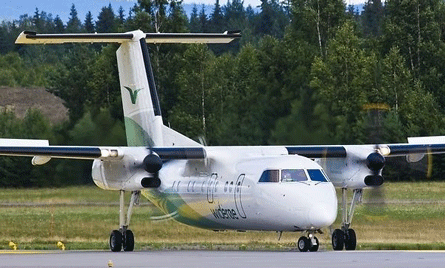The world's only certificated global navigation satellite system (GNSS) precision approach system guided its first passenger-carrying aircraft to touchdown on 29 October at a remote airport in Norway.
A Bombardier Dash 8-100 of SAS subsidiary Widerøe carried out the inaugural approach to Runway 04 at Brønnøysund.
Already approved by the Norwegian civil aviation authority and certificated by the European Aviation Safety Agency, the system will be installed at 24 of Norway's local airports where terrain or steep glideslopes make the installation or use of instrument landing systems impossible, says Steinar Hamar, the SCAT-1 programme manager at the country's airports and air navigation service provider Avinor.
|
|---|
© AirTeamImages.com/Jørgen Syversen |
Known as SCAT-1 (Special Category 1), the system is a local area differential GNSS precision approach system with ground-based augmentation that can provide descent to a Category 1 decision height, provided all the other requirements for Cat 1 - for example runway and approach lighting standards - are also met.
At the remote runways for which Avinor has commissioned the system, the latter is rarely the case, but SCAT-1 is replacing the non-precision step-down approaches previously required.
Jens Gjerlev, navigation manager at Widerøe, says that the impetus to improve approach safety became irresistible following the controlled flight into terrain accident to one of the airline's Dash 7s on approach to Brønnøysund in May 1988 that killed all 36 on board. The new system is more accurate than an ILS, with both vertical and horizontal trajectory GNSS-determined.
Avinor says work to develop a GNSS-based precision approach system began in 1997. Research, trials and winning institutional approval took far longer than expected, says Gjerlev.
Universal Avionics' GLS-1250 GNSS twin receivers/processors are at the heart of the on-board system, which is totally integrated with the aircraft's flight management system. The airport-located ground station that provides signal corrections and integrity assurance to the aircraft system by VHF datalink was developed by Norway-based Park Instruments.
SCAT-1 versus LAAS
SCAT-1 trials with ground-based augmentation systems (GBAS) were run by the US Federal Aviation Administration working with Continental Airlines in the 1990s, but abandoned when the FAA decided that wide area augmentation systems could produce Cat I approaches more cheaply. The US agency and postponed its GBAS programme known as LAAS (local area augmentation system).
With LAAS still shelved, Airservices Australia, working with the FAA, looks likely to be the first into the field with a GBAS that will meet International Civil Aviation Organisation standards for a precision GNSS approach certificated for general public transport use. Qantas first flew a GBAS GNSS approach on a trial basis at Sydney airport in November last year, and trials continue with a target for certification to ICAO Annex 10 standards by the end of 2008, and this has the potential to achieve Cat II or Cat III decision heights. The SCAT-1 system needs special approval for individual installations, and Avinor's system has been approved by the European Aviation Safety Agency.
Flying the SCAT-1 at Brønnøysund
Flight International's David Learmount witnessed two night SCAT-1 approaches to Runway 04 at Brønnøysund about 12h before the official inaugural flight, from the jump seat of a Widerøe Bombardier Dash 8-100. He describes what he saw arriving at Brønnøysund from Widerøe's main base at Bodo:
"From the pilot's point of view, flying the Avinor SCAT-1 system looks like flying an ILS. The difference is how the approach path is defined. The SCAT-1 system defines a line in space, and the aircraft's position relative to it is tracked both laterally and vertically by GNSS and the Brønnøysund GBAS installation. This invisible path starts at a predetermined height directly above the runway threshold and extends to a range of about 20nm [37km]. At Brønnøysund the glideslope is 3.9° and the approach azimuth is aligned with the runway at 037°.
"The pilot flying tuned in to the Brønnøysund SCAT-1 approach, designated by a four-digit number on the approach plate. Upon acquiring the GNSS signals corrected by the Brønnøysund GBAS, the system annunciator displayed 'DGPS' in green, and the pilot followed the same flight instrument guidance he would follow for an ILS to intercept the approach from the left, and began descent on intercepting the glideslope at the final approach fix. The instrument guidance was rock steady - no twitches - and when the runway lights appeared the aircraft was perfectly aligned. Both times."
Source: Flight International
























